Solar cooking creates perfect meals because the sun's gentle heat gradually brings food to ideal temperatures between 250°F and 350°F, allowing flavors to develop naturally. You'll notice the difference in taste as the slow cooking process preserves essential nutrients and vitamins that often get lost in traditional cooking methods. Your meals will retain more moisture, resulting in tender, juicy dishes with complex flavor profiles enhanced by natural caramelization. It's also a safer, more sustainable way to cook that saves you money on fuel costs while protecting the environment. Discover how this ancient cooking method can transform your everyday meals into extraordinary culinary experiences.
The Power of Solar Heat
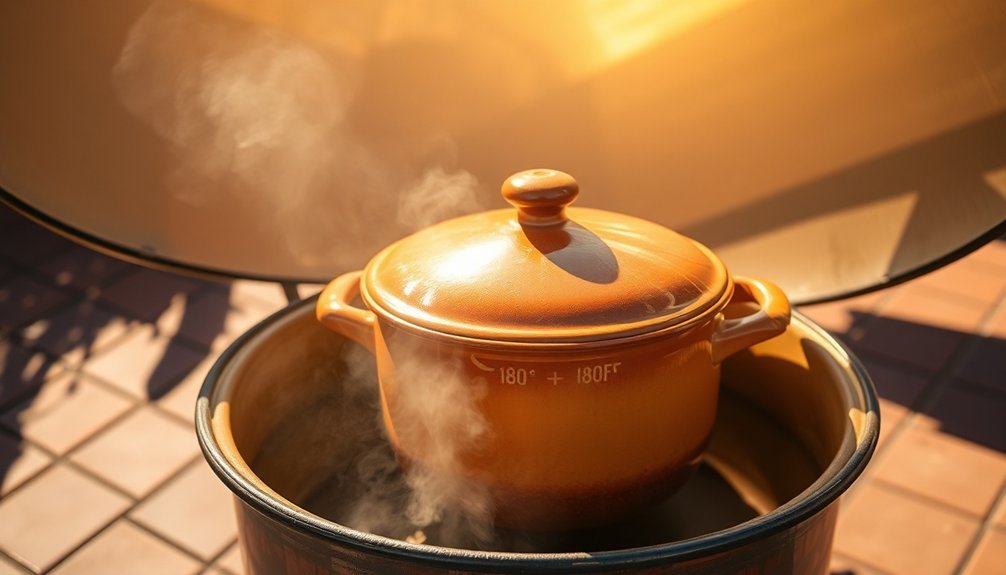
While traditional cooking methods rely on burning fuels, solar heat harnesses the sun's natural energy to create perfectly cooked meals.
You'll find that solar cooking uses reflective surfaces to direct sunlight to your cooking container, reaching temperatures between 250 and 350 degrees – perfect for most dishes. If you're interested in frying or grilling, parabolic cookers can achieve even higher temperatures.
What makes solar heat particularly efficient is its ability to store energy using various methods. This sustainable approach helps save 30 million tons of carbon dioxide emissions over the lifetime of solar cookers.
You can utilize solid materials like stones and bricks to retain heat longer, ensuring your food continues cooking even when sunlight varies. The technology's high thermal mass and conductivity enhance heat transfer, making it a reliable cooking method that doesn't compromise on performance while protecting the environment.
Preserving Natural Food Nutrients
When you cook with solar heat, you'll notice how nutrients remain locked within your food instead of escaping into cooking water or evaporating from high-heat methods.
You're preserving essential vitamin content as the sun's gentle warmth maintains steady temperatures that protect both water-soluble and fat-soluble nutrients.
The slow, natural heating process keeps minerals biologically active, making them more available for your body to absorb than with conventional cooking methods. Unlike high heat pasteurization, solar cooking helps maintain vitamin C levels in fruits and vegetables while still ensuring food safety.
Nutrients Stay In Food
Since traditional cooking methods can strip food of essential nutrients, understanding how to preserve these elements becomes important for maximum nutritional benefit.
You'll find that steaming and short cooking times are your best allies, as they help retain water-soluble vitamins like folate and thiamine. Using pure clay pots can greatly reduce cooking time while preventing toxic chemicals from leaching into your food. The gentle far infrared heat from pure clay ensures thorough cooking while preserving delicate nutrients that would otherwise be destroyed by harsh metal or ceramic cookware.
When you're preparing meals, opt for techniques like stir-frying or microwaving that require minimal cooking time. You can also preserve nutrients by choosing methods that use less water, such as grilling or roasting.
Don't forget to save cooking liquids when possible, as they contain valuable minerals. Remember to store ingredients properly and avoid excessive peeling, as nutrients often concentrate near the skin of fruits and vegetables.
Heat Retains Vitamin Content
Although high temperatures can diminish certain nutrients, proper heat application actually helps preserve vitamin content in many foods.
You'll get better nutrient retention by choosing cooking methods that match your ingredients. Steaming's gentle approach preserves up to 91% of vitamin C in vegetables like broccoli and spinach, while quick-cooking methods like stir-frying help retain B vitamins. Studies show that holding food hot for more than 2 hours can reduce vitamin C, folate, and B-6 content by up to 10%.
When you're cooking with sun-generated heat, you're using a gentler approach similar to slow-roasting, which helps protect heat-sensitive nutrients.
You can maximize vitamin retention by avoiding prolonged water exposure and excessive temperatures. If you're cooking water-rich vegetables, collect any cooking liquid to retain water-soluble vitamins that have leached out.
Remember that harder vegetables like beets and potatoes naturally resist nutrient loss during heating.
Natural Minerals Remain Active
Preserving minerals in food requires understanding how they respond to different cooking methods and storage conditions.
You'll get the most nutrients when you steam vegetables instead of boiling them, as water-based cooking can leach away essential minerals. When you're preparing ingredients, cut them just before cooking and keep pieces large to minimize mineral loss.
- Store fresh vegetables like kale and spinach in moisture-proof bags in your fridge
- Choose steaming over boiling to keep minerals intact
- Save cooking liquid from vegetables to use in soups and stews
- Soak beans, lentils, and nuts to improve mineral absorption
- Keep produce in opaque containers away from direct sunlight
Flavors Stay Locked Inside
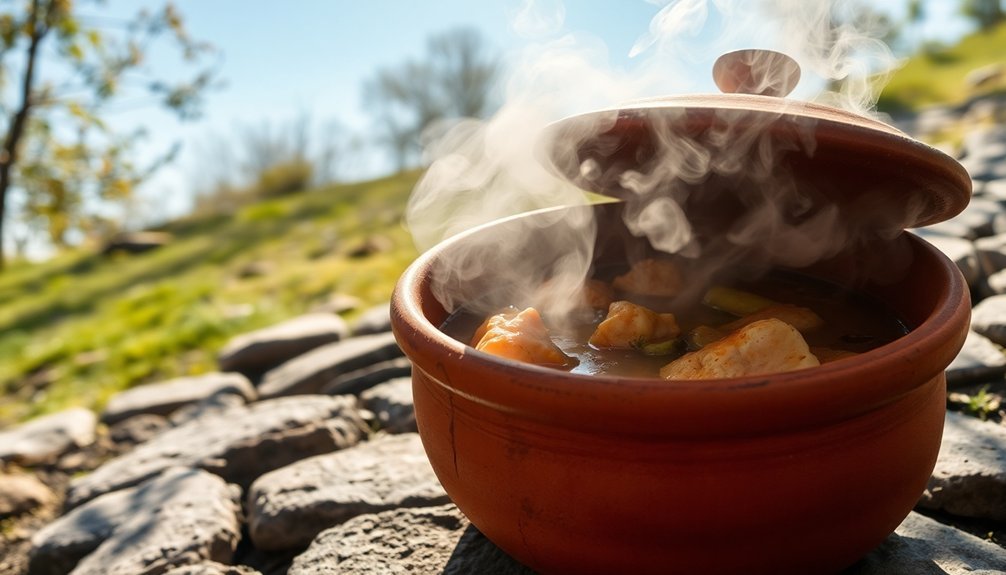
When food cooks slowly under gentle heat, complex chemical reactions create rich flavors that stay trapped within the dish. You'll notice this magic happening between 140°F and 165°F, where proteins and sugars interact through the Maillard reaction, developing deep, complex flavors that can't escape.
| Cooking Effect | Flavor Benefit |
|---|---|
| Moisture Lock | Juices stay trapped, preserving taste |
| Gelatin Formation | Creates rich, velvety mouthfeel |
| Slow Browning | Develops caramelized notes |
| Chemical Reaction | Produces new flavor compounds |
The gentle heat helps break down tough fibers while keeping the natural juices inside, resulting in dishes that are more flavorful and satisfying. You'll taste the difference in every bite as the slow cooking process allows flavors to develop fully and remain locked within the food.
Earth-Friendly Meal Preparation Methods
Modern sustainable cooking brings together environmentally conscious practices that benefit both your meals and the planet.
You'll find that using fresh, local ingredients not only reduces transportation emissions but also enhances flavor.
Solar cooking harnesses natural energy while preserving nutrients, and mindful food storage helps minimize waste.
- Use seasonal vegetables from local markets or your garden for stir-fries and salads
- Cook larger batches of lentil soup and chickpea dishes to save energy
- Store leftovers in airtight containers and repurpose them into new meals
- Compost food scraps to create nutrient-rich soil for growing herbs
- Choose solar cooking methods for dishes like baked vegetables and rice
Zero Carbon Cooking Solutions

As we shift to a carbon-neutral future, zero-carbon cooking solutions have emerged as powerful tools for sustainable meal preparation.
You'll find innovative options like solar cookers, electric stoves powered by renewable energy, and bioethanol systems that dramatically reduce your carbon footprint while creating delicious meals.
These solutions don't just help the environment – they're transforming lives.
You're protecting forests, reducing greenhouse gas emissions, and supporting biodiversity when you choose clean cooking methods.
Smart technologies like pay-as-you-go gas stoves and metered cooking devices make these options more accessible than ever.
Saving Money While Cooking Better
Since switching to solar cooking can dramatically reduce household expenses, you'll find significant savings in both the short and long term.
You can cut your fuel costs by up to 40% in dry seasons and 35% in wet seasons, stretching your existing fuel supplies for when you truly need them. This sustainable cooking method requires minimal maintenance while delivering years of reliable service, making it an excellent investment for your household.
- Save up to one-third of your monthly wages previously spent on charcoal
- Reserve your gas and coal supplies for rainy days and nighttime cooking
- Redirect saved money to other essential household needs
- Generate additional income through solar cooking activities
- Enjoy nearly zero maintenance costs with free solar energy
Safer Than Traditional Cooking
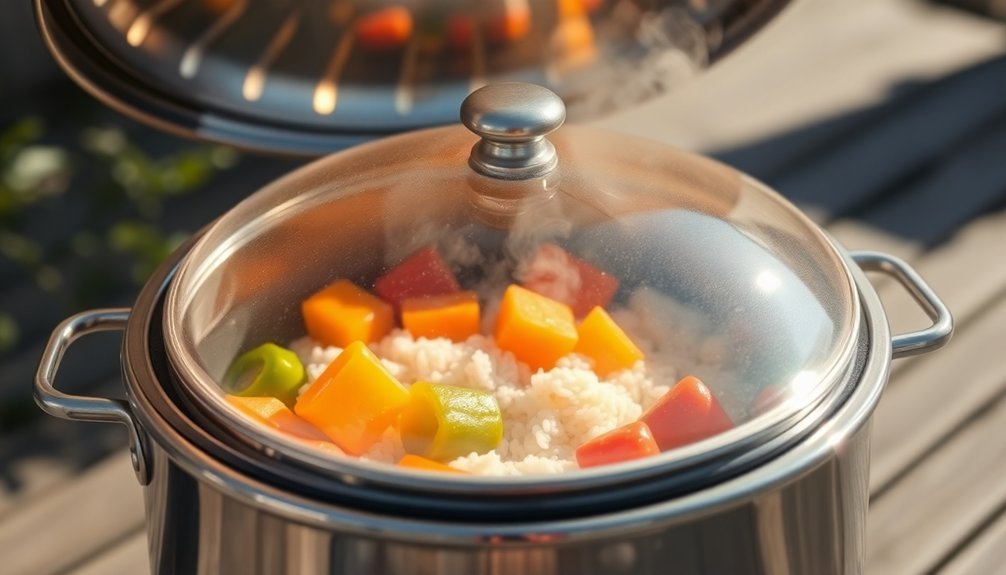
You'll notice an immediate safety benefit with solar cooking since there are no open flames or hot surfaces to cause accidental burns.
The sun's gentle heating allows for better temperature control, making it nearly impossible to scorch food or create dangerous hot spots that could harm you.
Your cooking becomes safer through the steady, controlled heat that reaches ideal temperatures without the risks associated with traditional stoves or open fires.
No Burn Hazards
While traditional cooking methods pose various burn risks, solar cooking stands out as a remarkably safer alternative. You'll find that solar cookers eliminate the dangers of open flames and direct fire contact, greatly reducing burn-related accidents.
Though you'll still need to handle hot cookware carefully with oven mitts, the only heated surface you need to watch out for is the cooking pot itself.
- No open flames to cause accidental burns
- No risk of gas leaks or fire-related injuries
- Gradual heating process prevents sudden temperature spikes
- Only the cooking vessel becomes hot, not other components
- Simple safety measures like pot holders provide adequate protection
The gentle, consistent heat from the sun creates a safer cooking environment, especially if you're cooking with children nearby or in areas where traditional fuel sources pose inherent risks.
Temperature Control Made Easy
Despite its reliance on sunlight, solar cooking offers remarkably precise temperature control through simple adjustments. You can raise or lower temperatures by repositioning reflectors, adjusting the cooker's angle to the sun, or modifying lid placement for ideal heat retention.
You'll find several ways to monitor cooking temperatures, from built-in gauges to traditional thermometers. By opening or closing the insulated cooking core and adjusting collection panels, you're able to maintain your desired heat level.
For more precise control, you can briefly remove food to cool it before returning it to the cooker.
These temperature control methods not only help you create perfectly cooked meals but also contribute to significant cost savings. You'll eliminate fuel expenses while reducing your home's cooling needs, especially during hot summer days.
Perfect For Outdoor Adventures
Since outdoor enthusiasts often seek lightweight and portable cooking solutions, solar cooking has emerged as a game-changing option for adventurers.
You'll find it particularly valuable in remote areas where traditional fuel sources are scarce or restricted. Whether you're camping in the desert or hiking through mountains, this versatile cooking method adapts to various environments while keeping safety a priority.
- Set up your solar cooker quickly without tools, making it perfect for spontaneous outdoor meals
- Purify water and prepare nutritious meals while preserving natural flavors
- Cook safely without open flames, reducing fire risks in dry environments
- Enjoy community-style cooking as you gather around to prepare meals together
- Use it confidently in sunny locations like Ehrenberg, where you'll get over 300 days of sunshine yearly
Getting Started With Solar Cooking
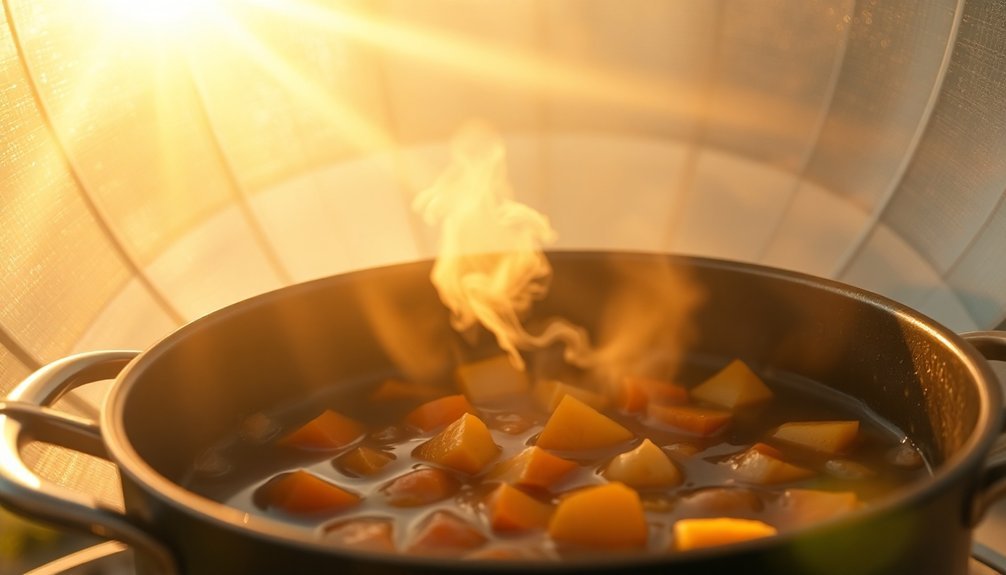
Three essential steps will help you begin your solar cooking journey: understanding the basics, selecting the right equipment, and mastering proper setup techniques.
First, you'll need to grasp how sunlight converts into heat energy through reflective surfaces and a black-painted cooking chamber. A clear glass or plexiglass cover traps this heat, creating an efficient cooking environment.
When choosing your solar cooker, consider your cooking needs. Box cookers work well for basic baking, parabolic models reach high temperatures for frying, and tube cookers perform effectively even in low light.
Remember to place ingredients in a sunny spot and adjust reflectors for maximum sun exposure.
You'll want to monitor your food closely, rotating solid items and stirring liquids every 10-15 minutes for even cooking.
Don't forget basic safety: avoid looking directly at reflective surfaces and use protection when handling hot equipment.
Best Foods For Solar Cooking
While solar cooking works with most recipes, certain foods excel in this gentle cooking method. You'll find that dishes requiring slow, steady heat turn out exceptionally well. From simple snacks to hearty stews, solar cooking brings out rich flavors while preserving nutrients and moisture.
- S'mores and nachos melt perfectly in minutes, making them ideal starter recipes.
- Baked fish and roasted meats retain their natural juices without drying out.
- Stews and soups develop deep flavors as they simmer in the consistent heat.
- Breads and desserts bake evenly, creating perfect texture and moistness.
- Fresh vegetables like corn and potatoes maintain their nutritional value.
Whether you're camping or cooking in your backyard, you'll discover that solar ovens transform basic ingredients into delicious meals while using nature's free energy source.
Seasonal Solar Cooking Tips
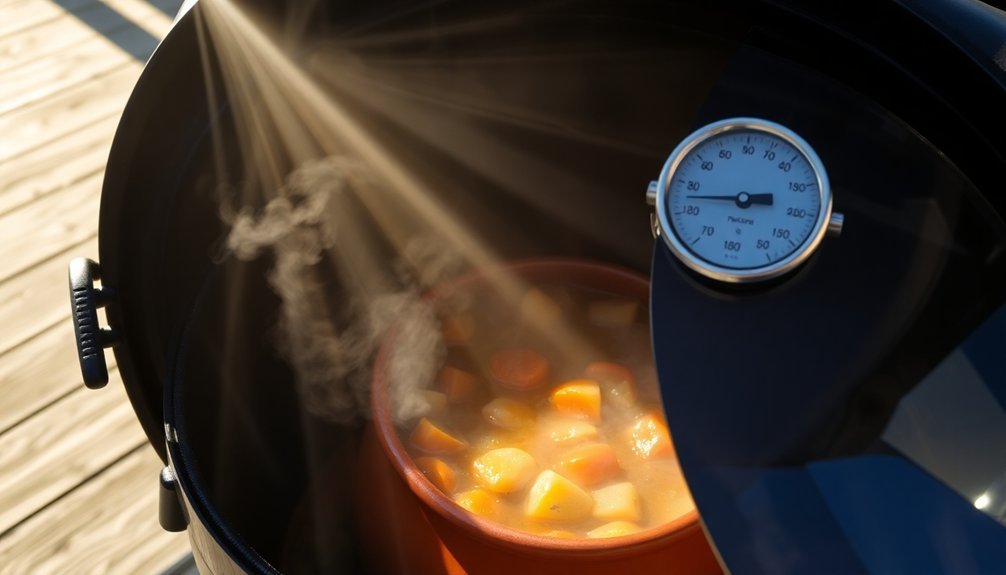
To make the most of solar cooking throughout the year, you'll need to adjust your techniques based on seasonal changes and weather patterns. During winter, you'll want to preheat your cooker and track the sun more frequently, while summer offers longer cooking windows with less adjustment needed.
| Season | Best Hours | Key Tips |
|---|---|---|
| Summer | 11am-3pm | Less tracking needed, ideal for baking |
| Winter | 10am-2pm | Use snow reflection, frequent tracking |
| Cloudy Days | 11am-2pm | Focus on slow-cooking meals, use reflectors |
Don't let challenging weather discourage you. Even in cloudy conditions, you can achieve temperatures between 200-250°F, perfect for cooking meats and vegetables. For best results, always preheat your cooker and seal containers tightly to maintain heat. In colder regions, consider preheating indoors before moving your setup outside.
Building Your Solar Kitchen
To build your solar kitchen, you'll need basic equipment like a sturdy box, reflective materials, and transparent covers, which typically cost between $10-$50 for a complete setup.
Your chosen location should have unobstructed sun exposure between 11 am and 3 pm, with enough space to adjust your cooker's position throughout the day.
Setting up your cooking station on a stable, flat surface with easy access to basic tools and temperature monitoring devices will guarantee ideal cooking results.
Essential Equipment to Start
Success in solar cooking begins with gathering the right materials for your DIY solar oven. You'll need basic items like cardboard boxes, glass or plastic for the top, and aluminum foil for reflection.
Heat retention and insulation are essential, so gather foam board or polystyrene, plus weather stripping to create airtight seals.
- Large cardboard boxes or pizza boxes serve as your oven's main structure
- Clear glass or plastic pane acts as your cooking window
- Aluminum foil creates important reflective surfaces
- Black paint or construction paper absorbs heat effectively
- Foam board or newspaper provides significant insulation
Don't forget your basic tools like a tape measure, razor knife, and thermometer to monitor cooking temperatures.
With these materials ready, you're set to build an efficient solar cooking system that harnesses the sun's energy.
Location and Setup Tips
Building your solar kitchen begins with selecting the perfect location for ideal sunlight exposure.
You'll want a spot that gets direct sun throughout the day, away from trees, buildings, or anything that casts shadows.
It's best to position your setup where it's protected from strong winds while staying clear of dust and debris.
For best cooking results, you'll need to angle your solar panels and cookers correctly.
Use adjustable stands to track the sun's movement, and don't forget to preheat your solar oven for an hour before cooking.
The prime cooking window is between 11am and 3pm.
Use black pots to absorb heat effectively, and enhance performance with reflective surfaces like tin foil.
Remember to monitor temperatures with a cooking thermometer and adjust times based on weather conditions.
Community Solar Cooking Benefits
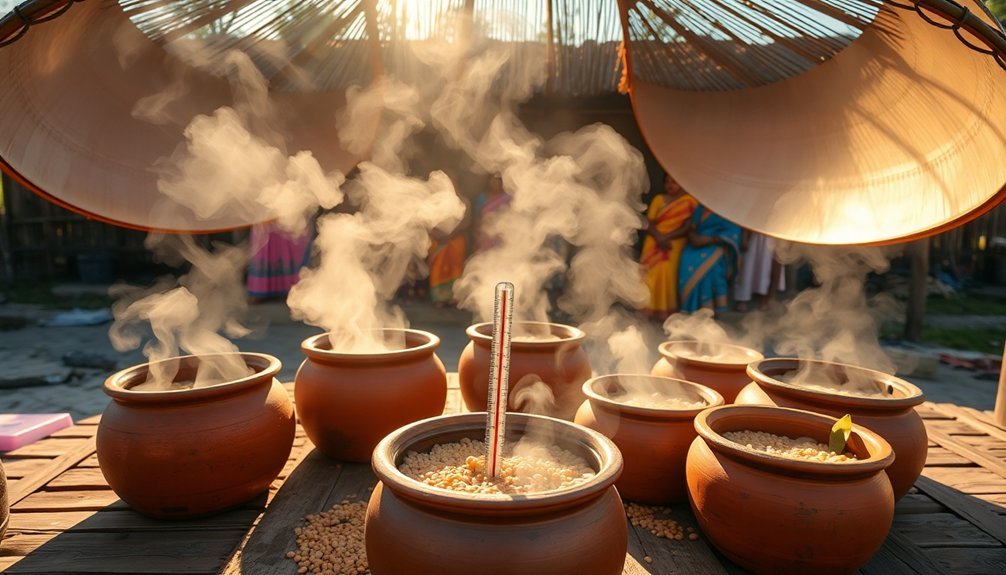
Solar cooking offers transformative benefits that extend far beyond individual households into entire communities. When you adopt solar cooking, you're contributing to a healthier environment while strengthening local economies.
Communities that embrace solar cooking report significant reductions in fuel expenses, allowing families to redirect resources toward education and other essential needs.
- You'll spend less time gathering firewood and more time focusing on work or education
- Your community's air quality improves as fewer households rely on traditional cooking fires
- Local employment opportunities increase through solar cooker construction and maintenance
- Your water becomes safer through solar pasteurization
- You'll help preserve local forests and biodiversity by reducing wood consumption
These advantages create a ripple effect, fostering resilient communities while promoting sustainable practices that benefit everyone.
Frequently Asked Questions
Can Solar Cookers Work Effectively on Cloudy or Partly Cloudy Days?
Your solar cooker's effectiveness drops considerably on cloudy days, but you can still cook on partly cloudy days at lower temperatures (200-250°F). You'll need longer cooking times and should consider alternative methods for fully overcast conditions.
How Long Does It Typically Take to Cook Meat Safely?
You'll need 15-45 minutes for thin cuts and up to several hours for thick, tough meats. Check internal temperatures with a meat thermometer – poultry needs 165°F, beef 145°F, and ground meats 160°F.
What Happens if Animals or Birds Are Attracted to the Cooking Smells?
You'll need to protect your food since cooking smells attract both mammals and birds. Keep your cooking area covered and secure, and don't leave food unattended to prevent unwanted wildlife encounters.
Do Solar Cookers Require Special Cookware or Can Regular Pots Work?
You'll get the best results using dark, thin metal pots with tight-fitting lids. While regular pots can work, they're less efficient. You can improve regular cookware by blackening them or using oven bags.
Can Solar Cooking Affect the Texture of Baked Goods Like Bread?
Yes, you'll notice your solar-baked bread has a softer crust and more tender crumb. It won't be as crispy as conventional oven bread because of the lower, steadier temperatures and longer cooking time.
In Summary
You'll find solar cooking transforms not just your meals, but your entire approach to food preparation. Whether you're baking bread, simmering stews, or slow-roasting vegetables, the sun's gentle heat preserves nutrients while developing rich, natural flavors. Start small with a simple solar oven, and you'll soon discover why this ancient cooking method creates perfect meals while protecting our planet's future.

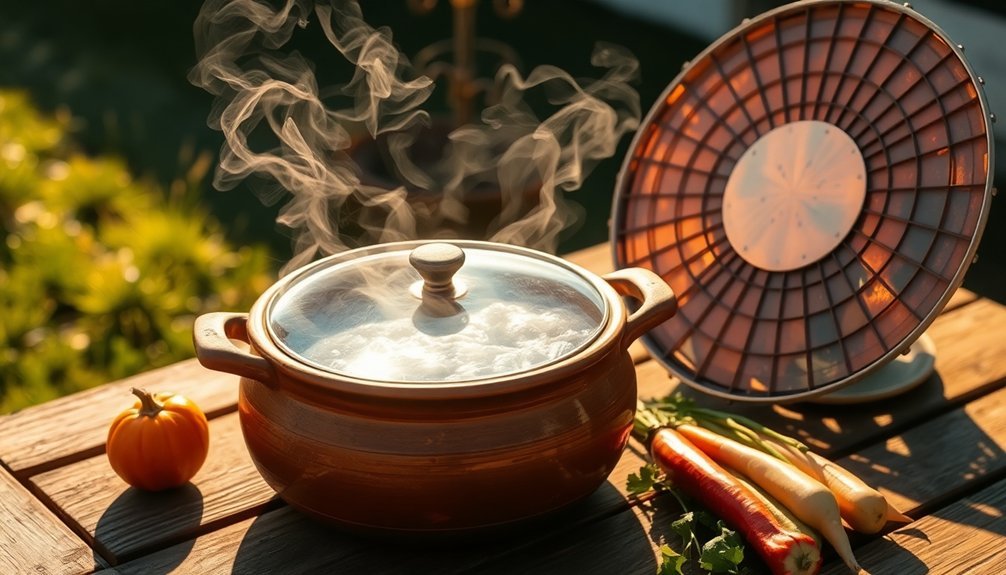



Leave a Reply